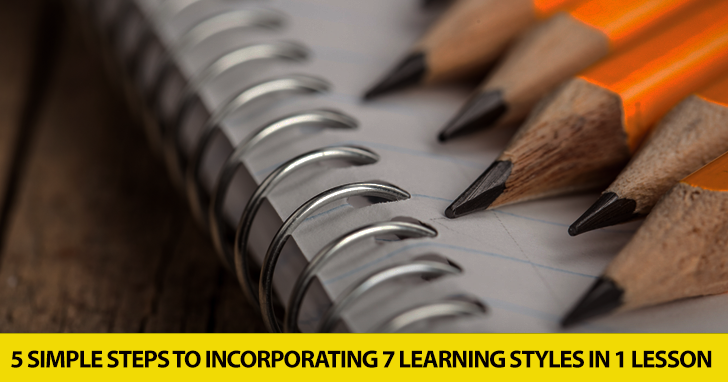Seven in One Blow: 5 Simple Steps to Incorporating 7 Learning Styles in One Lesson


Anyone can. It’s just a matter of keeping in mind the essentials of every great lesson. Here are seven things you need to know before you give your next grammar lesson.
If you are teaching grammar right at your students’ level, you might be doing it wrong. The best grammar lessons will be just a bit more advanced than what your students are already comfortable with. If you teach material that is too easy, students will check out. If you teach material that is too hard, students will check out. So the best grammar lessons walk the fine line between ease and difficulty. In teaching text books, it’s referred to as i+1. If i is what your students know, the target material is just a little bit beyond that. When you teach at i+1, students will be able to grasp and understand the new grammar concept while still being able to link it to what they already know.
One key to any great lesson is making sure you connect with your students’ learning styles. You have probably heard about these learning styles before: visual learners, auditory or aural learners, and kinesthetic learners. Most people learn through one of these means – through what they see, through what they hear, or through what they experience in a hands on way. The best lessons incorporate all of these elements. If you tell your students the information they need, you are teaching in a style that works for aural learns. If you also make notes on your board or refer to things written in your text book, you are incorporating visual aspects to your lesson. Kinesthetic elements may be more difficult for you to include. Or at least, they may not be the first types of activities you think of (unless you happen to be a kinesthetic learner yourself). You can easily include hands on aspects to your lesson, however. Try giving students something to manipulate as they learn, such as words written on small slips of paper or props that you can use in your explanation. Get your students moving to engage their kinesthetic senses. Have them go to different areas of your classroom, or act out something you are teaching. If you can specifically include activities that appeal to each of these three types of learners, you will have a grammar lesson that everyone will enjoy and benefit from.
One of the best ways I have used to warm up my grammar class is by showing them why they need the grammatical structure that I will be teaching. Making students aware of the need before you teach the solution will get students thinking about the structure they are currently missing in their grammar-minds. They will pay more attention when you present the information, and they will have an immediate way to apply what they have learned. You don’t want to discourage your students by giving them a problem they can’t solve just so they pay attention during your lesson. Just help them be aware of what they need. Try giving a discussion question that elicits the target structure to get the ball rolling before you give them the tools to accomplish it.
That doesn’t mean you can’t talk when you give a lesson or that the classroom should be quiet from start to finish. In fact, you do want a classroom filled with voices, but those voices should not be your own. It is easy to fall into lecture mode when you teach a grammar lesson. You are the one with the information. You want to give that information to your students. But the more time you spend teaching, the less time your students will be communicating in class and therefore the less time they are using English. The best grammar lessons are those where your students do most of the talking. You might try the discovery method of teaching grammar, where you give them an exercise on the target structure along with the answers before you teach the concept. Challenge your students to figure out the rule on their own before teaching it to them. This way, your students spend more time talking with each other than you spend talking at them, and when they discover the grammar rule on their own they are more likely to remember it.
Filling in the blanks in a textbook exercise is okay, but it’s not the only way your students should practice the grammar they are learning in class. The best grammar lessons give students a chance to practice the target structure in their spoken language as well as their written language. Filling in the blanks is good for teaching a grammatical rule or pattern, but don’t stop there. Push your students to use what they are learning in a conversation with a classmate or to by writing a paragraph or two. As they practice this way, listen and check their work and give feedback one on one as much as possible.
Where in the real world will your students encounter the language structure you are teaching in class? Can you bring that situation into your classroom? We have all heard about realia and bringing it into the classroom, but what exactly is realia? It is real life material that your ESL students can use in the classroom. You might bring in a menu, a bus schedule, or a newspaper. Any of those is realia and is a great way of connecting the real world with the classroom. When you teach your next grammar lesson, think about where students might see and use that structure outside the ESL classroom, and then bring those connections into your room.
I am a strong proponent of the communicative classroom. A communicative classroom is one that stresses communication between students. It means putting abstract knowledge to practical application and using the language in speaking or writing. Your best grammar lessons will be ones that students use to communicate with each other. This doesn’t mean assigning exercises from the text book, though those are good in moderation. A communicative activity uses the target structure to accomplish a real life goal. For example, if you are teaching modals, ask your students to talk about what could be done to improve the classroom or the school grounds. Give them a real life application of the language and then let them use it in conversation.
By keeping these seven keys in mind, you will be a better teacher and your students will be better learners because of it.